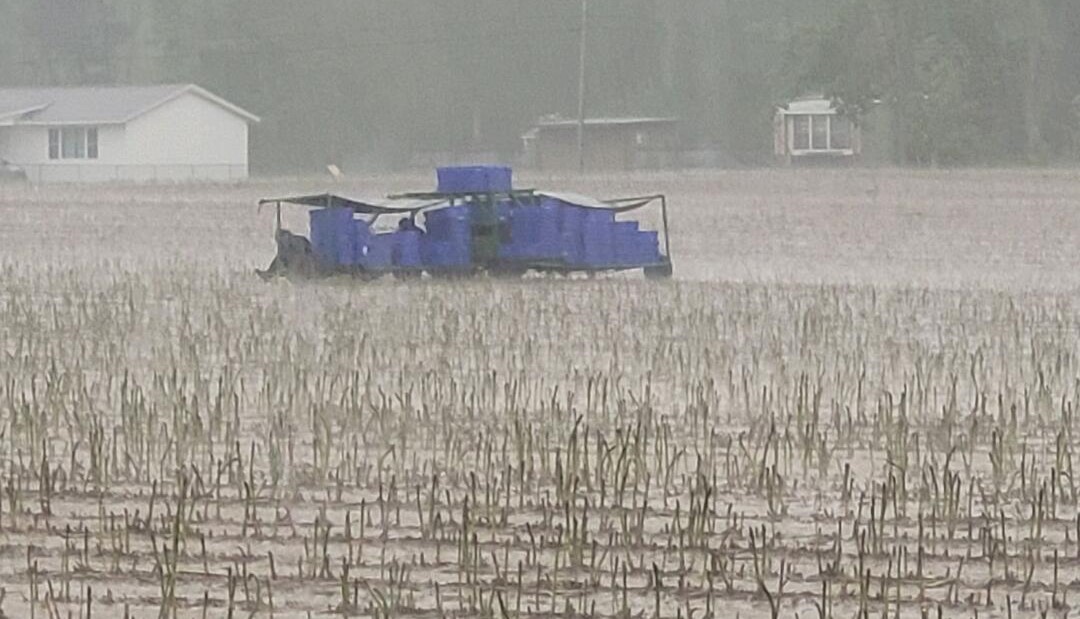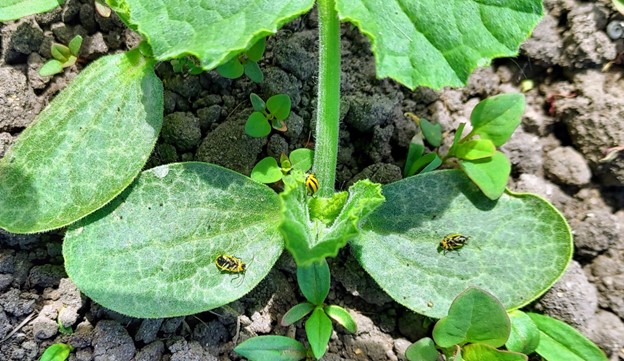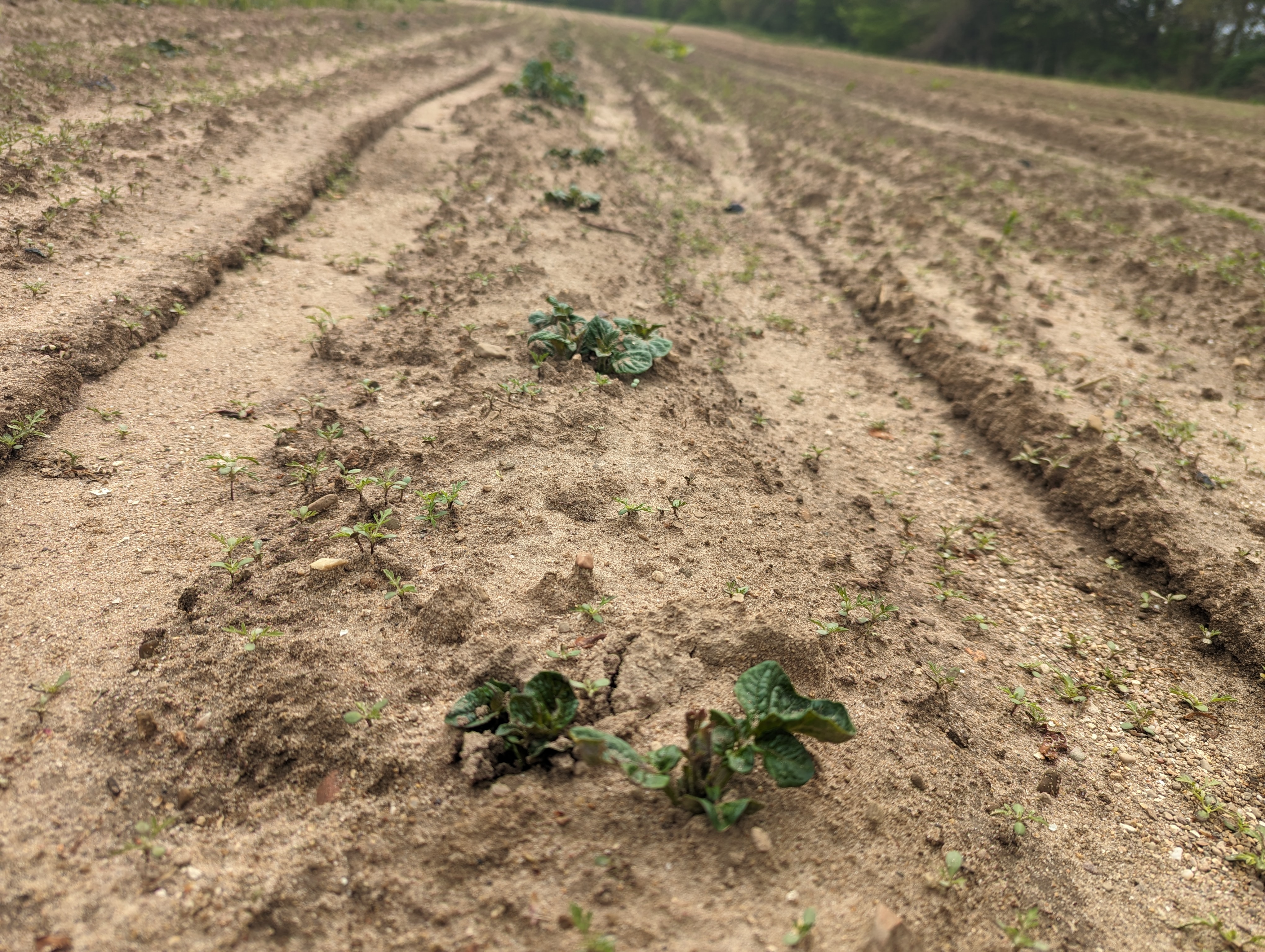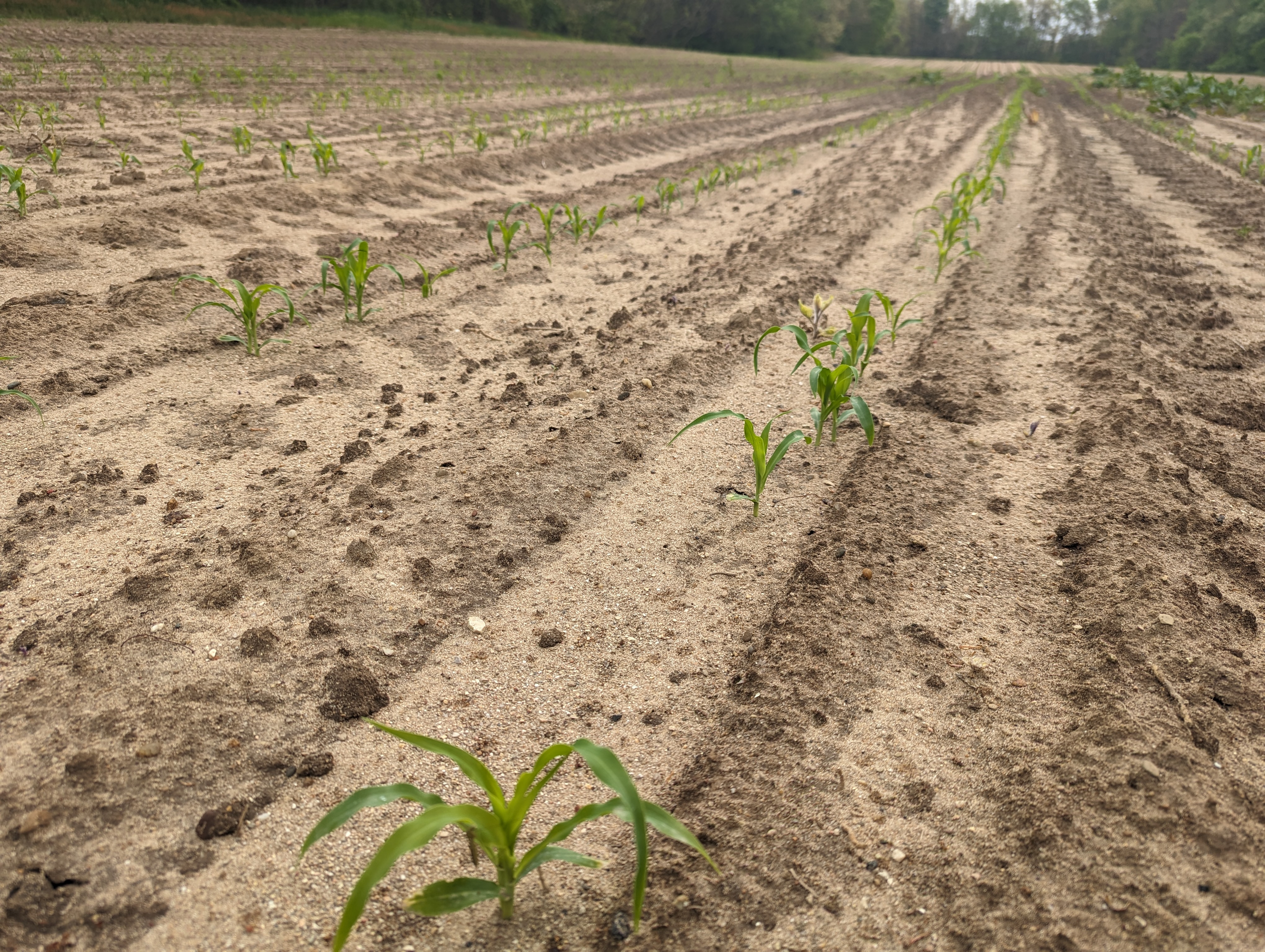Michigan vegetable crop report – May 8, 2024
Follow best practices for managing greenhouse transplants and early-season pests in the field.

Weather
Unusually strong, long-lived tornadoes hit at least four southwest counties overnight, part of a broader outbreak across the United States. For the past week, temperatures were above normal with precipitation varying from less than 0.25 inches in northeast Michigan to 1 inch in the west and north. Degree-day accumulations (base 50 degrees Fahrenheit) are one to 1.5 weeks ahead of normal.
This week’s forecast includes:
- Precipitation totals through next Wednesday, May 15, of 0.5-0.75 inches southwest decreasing to the north.
- Light rain ending in the north Wednesday morning, May 8. Mostly fair and dry elsewhere. Rain developing again southwest overnight Wednesday and spreading northeast across the southern half of the state Thursday. Fair, dry and cool Friday. Scattered showers possible statewide Saturday and Sunday.
- High temperatures from the upper 60s to upper 70s Wednesday, falling back to the 50s Friday and gradually warming back to the 60s and low 70s again by early next week. Low temperatures in the upper 30s in the north to low 50s in the south on Thursday morning falling to the 30s in the north to upper 40s in the south on Friday. Frost and freezing temperatures possible in the interior of Upper Michigan. Lows gradually warming back to the 40s in the north to low 50s again by early next week.
- Medium range outlooks generally call for near to above normal mean temperatures and precipitation totals during the second half of May.
Grants
The U.S. Department of Agriculture (USDA) announced today, May 8, approximately $22.3 million available to community-based and nonprofit organizations, institutions of higher education, and Tribal entities that help underserved and veteran farmers and ranchers own and operate successful farms. Funding is made through USDA’s 2501 program. This program is administered by USDA’s Office of Partnerships and Public Engagement.
Eligible applicants include not-for-profit organizations, community-based organizations and a range of higher education institutions.
Applications must be submitted through grants.gov and received by Friday, July 5, 2024. Visit the 2501 Program page for more information on the 2501 funding opportunity.
Crop updates
Herbicide updates
Check out this article about new and renewed herbicide labels for vegetables in 2024, including Optogen, Rely and Reflex.
In our first report of the season, we mentioned soil type and its effects on herbicide performance. Yet another consideration is water quality and how it affects herbicide activity in its role as a carrier. Water quality factors that can influence efficacy include hardness, pH, turbidity and more. Check out this article from Purdue for a more detailed account of how water and pesticides can interact and how that may influence crop protection results.
Vegetable transplants
Damping-off basics
Damping-off affects a wide range of greenhouse vegetable and herb plants and requires a disease prevention and management plan. Pythium and Rhizoctonia are fungi commonly associated with damping-off. Damping-off fungi can occur early in production by causing a seed rot and attacking seedlings before they emerge from the soil. While growers may think the reduced germination is due to poor seed quality, damping-off fungi may be to blame. Post-emergence damping-off is more readily recognized because the damping-off fungus attacks at the soil line after the seedling emerges from the soil and causes water-soaking and constriction on the lower stem. Seedlings collapse at the point of constriction.
Damping-off fungi can also infect recently established transplants resulting in water-soaking stem discoloration and rot, thereby preventing the formation of a robust root system. Rhizoctonia fungi typically cause a dull brown to dark brown rot on the stem at the soil line. When Pythium is involved, the blight may have a dark gray to black appearance. In some crops, Botrytis can be a primary problem or come in as a secondary issue. Spores of the Botrytis fungus can be present in nearly all greenhouse growing systems and can cause a blight similar to that described for Rhizoctonia. When Botrytis is the problem, the production of fuzzy, gray spore masses on the blighted tissue will give the culprit away. Botrytis can become a problem under humid and wet conditions when air movement is limited and the weather is overcast.
Sanitation is the keystone in preventing and managing damping-off caused by the root rot pathogens such as Pythium and Rhizoctonia. Healthy-looking seedlings grown near plants that have damped-off may be infected with the damping-off fungus and suddenly collapse after transplanting. Sudden plant death may also occur if particles of the growing medium carrying the damping-off fungus are transferred from the infested flat and contaminate the new growing medium.
When conditions are unfavorable for infection, damping-off fungi form a survival structure that may be found where used soil or plant debris accumulate. Used pots or flats, flat fillers, bench top and potting areas are some of the places where infested soil and plant debris may be found. Without proper disinfection, use of these areas results in spreading of infested soil particles from infested to clean areas of the greenhouse. Also, infested soil particles from greenhouse walkways and floors serve as inoculum that may be unknowingly transported throughout production areas by greenhouse personnel.
Fungicides applied as drenches have been an important tool in preventing damping-off and halting its spread, especially in greenhouse flowers. There are few fungicides available for use in vegetables and herbs. The fungicide Subdue (mefenoxam) can be used only at seeding as a soil surface spray and should be irrigated lightly after application to move products into the root zone. This product is active against Pythium, Phytophthora and downy mildew, and can be used only at seeding on brassicas, leafy greens, eggplant, pepper, tomato and herbs. The fungicide Switch (fludioxonil plus cyprodinil) has a label for use as a spray for some greenhouse vegetables and herbs and can be helpful for Botrytis, leaf spotting fungi and Rhizoctonia.
Before using any fungicide, check the label to ensure the crop is listed and use in the greenhouse is not prohibited. Biocontrol agents are widely available for use in controlling damping-off fungi and should be used preventively. Growing mixes that are naturally suppressive to damping-off soilborne fungi are also widely available to growers. A suppressive medium is one that represses, restrains or checks the growth of damping-off fungi.
Damping-off prevention
- Use a well-drained growing medium. Using sand and or soil in the growing mix is not generally recommended unless the materials can be steamed to eliminate damping-off fungi.
- Use clean equipment, flat fillers and workbenches. While steaming is an effective means of disinfecting, treatment with commercially available disinfectants or a 10% Clorox formulation (one part chlorine bleach to nine parts water) is also helpful. Disinfectants are likely to be most effective when soil particles and plant debris have been removed from the surface to be disinfested. Using a power washer can help to remove soil particles from a surface prior to treatment with a disinfectant. Note: Disinfectants are regulated as pesticides. Contact your state regulatory agency if you have questions concerning the labeled uses.
- Circulate air to prevent wet and dry pockets.
- Keep temperatures sufficiently warm so that seeds germinate rapidly and seedlings are vigorous. Seedlings become more resistant to damping-off as they mature.
- Manage shore flies and fungus gnats. Larvae of these insects feed on plant roots and can ingest damping-off fungi. The fungi can stay in the insect's gut from the pupal stage through the adult stage. The adults can then transmit the fungal spores aerially.
Damping-off management
- Remove any diseased plants from the growing area immediately. Do not reuse containers from diseased plants. Never reuse growing media.
- Identify the cause of damping-off. Don't assume a fungus is responsible for the problem - rule out environmental factors first. If a fungus is involved, identifying the specific fungus causing the disease is a must. Without an accurate diagnosis, the incorrect fungicide may be used and the damping-off will continue.
- Use a fungicide appropriate for the specific fungus involved. For instance, a fungicide that controls Pythium likely will not control Rhizoctonia. Sometimes, more than one damping-off fungus is a problem and a combination of fungicides and approaches may be helpful.
Asparagus
Asparagus harvest in west central Michigan started last Wednesday through Saturday depending on the farm. The start has been a bit disorienting in terms of timing, but weather was conducive to good tip quality. Some farms had already made significant progress by Tuesday with major pounds picked—a week ahead of our normal start date! Other farms were just getting into the swing of things this week. Wherever we are, the moderate weather and soil moisture have meant excellent tip quality so far.
Southwest Michigan growers have been producing significant pounds and endured some rough weather, including tornadoes, this week. Picking still happened despite the rain.
Purple spot can cause issues by blemishing spears. Risk of issues is highest during cool, wet weather. Rainfall is needed for spore production, and cool weather means there is more time between emergence and picking for blemishes to develop after spores infect spears. Some early spears had purple spot in west central Michigan, but thankfully new spears were blemish-free and had great tip quality. Hopefully the upcoming weather cooperates.
Asparagus beetle is the next pest to watch out for. Recent trials by Zsofia Szendrei’s lab showed that carbaryl and acetamiprid (e.g., Assail) are both highly effective and have a one-day preharvest interval (PHI). Beetles are more active in sunny, warm weather (and perhaps are more likely to encounter insecticide residue during those periods).

Brassicas and greens
Transplants of cabbage and other brassicas have been going in since early April and continue as weather allows. Growers are laying out irrigation pipes in the earlier planted cole crops.
Some west central growers have made the switch to using tray drenches of Verimark for cabbage maggot. If you do this, consider scouting for caterpillars. Verimark provides early season caterpillar and flea beetle control, so it could be interesting to watch for these pests to time sprays.

Cucurbits
Squash and cucumbers have started going in on plastic mulch. It is common for conventional growers to use a seed treatment containing an insecticide like the neonicotinoid thiamethoxam (in FarMore FI400). This product is systemic, granting protection against striped cucumber beetles for the critical first few weeks, when plants are vulnerable. Treated seed is not always available for specialty varieties. However, some imidacloprid products (e.g., Admire Pro) are labeled for soil application and can be effective. There are multiple ways to apply these, showcased on the label.

Fruiting vegetables
Hoophouse tomatoes are just starting to be harvested and early field tomatoes are just starting to be transplanted on some farms for both processing and fresh market. Some hoophouse tomato growers choose to switch to completely soil-less potting mix in bags. This is a sort of hybrid hydroponic system that requires a complete fertigation plan. With this system, a landscape cloth is helpful to keep weeds out. If you expect lots of foot traffic or wagon use, and do not intend to convert back to in-soil production, it could be worth installing a layer of packing sand and compacting it before laying the landscape fabric. This creates a much more stable surface under the fabric and can prevent tears from stretching and catching on shoes. This can improve the surface such that it could be used as a sales space with tables and plants as well.
Onions and garlic
In the east side of the state, direct seeded onions were in flag stage last Thursday. Transplanted onions are ready to go in the field.
Maggots have mostly been a non-issue in direct-sown onions since the arrival of effective seed treatments, but occasional very frustrating issues can pop up. Research at Cornell University found that onion maggot is by far the dominant species throughout most of the season in direct-sown New York onions. Another related species, seedcorn maggot, is less common but can cause issues. Some of the active ingredients in these seed treatments include cyromazine (in Trigard, a part of some packages), spinosad (e.g., in Lumiverd) and thiamethoxam (Cruiser, a part of some packages). Spinosad is effective against both maggot species, cyromazine is highly effective for onion maggot but less effective for seedcorn maggot, and thiamethoxam adds a little activity against seedcorn maggot. Currently, there are no effective rescue treatments if onions become infested with either species. Even with drenches, it is very difficult to contact maggots tunneling in roots, so drenches likely mean lots of time and water with minimal results. Thankfully, onions become less susceptible to onion maggot as they develop, and warming soils ward off seedcorn maggot issues.
A quick note on seedcorn maggot: Problems are very weather- and management-dependent. Females prefer to lay eggs in soils with lots of freshly decaying organic matter (for example, recently incorporated cover crops). Soil temperature also plays a major role. Past work in other crops showed the risk of problems is greatly reduced once soil temperatures at a 4-inch depth consistently hit 70 F each day.
Root crops and potatoes

Root crops are up and have been at a standstill but are starting to grow now with the moisture and warmer weather. Weeds too! Wondering what herbicides are labeled for weed control in root crops? The Midwest Vegetable Guide is a place to check. Follow labels for variety restrictions, soil type considerations, and timings based on crop height or leaf number.
Sweet corn
Early planted sweet corn is progressing well with succession plantings going in as weather/field conditions allow. Sweet corn is always a top crop that consumers flock to. The premium associated with being the first at the market with sweet corn has spurred a horticultural arms race for who can harvest the earliest ears.
Unlike tomatoes, it is usually not profitable to use high tunnel space for sweet corn, but growing on plastic has been gaining in popularity. This can either be black plastic mulch like any other warm-season crop or a clear plastic laid over the rows to heat up the soil. Even transplanting has been tried; some have found success here, but timing appears to be critical. Sweet corn can be severely stunted if the plants become rootbound in their cells before planting.
Selecting varieties that have the shortest days to maturity (while trying not to sacrifice sweetness/flavor) is another tactic. It’s important to recognize days to maturity as listed in the seed catalog is a ballpark number, with temperature and moisture in any given year having a substantial impact on actual days to maturity. In a year like this where we are ahead in growing degree-days, the combination of best practices for early sweet corn can make all the difference between being one of the first to have ears and being just another sweet corn stand in an already saturated market.

Strawberries
Flowers have emerged. With bloom and bee activity, do not use insecticides. Cool, wet conditions can favor angular leaf spot, a bacterial disease. The only effective bacterial controls are copper formulations. Growers are looking at early season herbicides to control overwintering weeds and are finishing up spreading straw. Check the PHI when selecting an herbicide.
Events
- May 9, 7-8 a.m., Field Crops Virtual Breakfast Series: Managing Corn and N After Waterlogging
- May 13, St. Joseph County Pesticide Applicator Training
- May 15, Hillsdale County Pesticide Applicator Training
- May 16, 7-8 a.m., Field Crops Virtual Breakfast Series: Post Weed Control Management
- May 23, 7-8 a.m., Field Crops Virtual Breakfast Series: Dry Bean Planting Options
- May 30, 7-8 a.m., Field Crops Virtual Breakfast Series: Wheat Fungicide Recommendations
- May 31, Oakland County Pesticide Applicator Training
- June 6, 7-8 a.m., Field Crops Virtual Breakfast Series: Sprayer Setup
- June 8, 9 a.m.-4 p.m., Soil and Composting Field Day
- June 11, 6:30-8 p.m., Western Lake Erie Basin State of the Lake Meeting: Lenawee County
- June 13, 7-8 a.m., Field Crops Virtual Breakfast Series: Irrigation Management
- June 13, 6:30-8 p.m., Western Lake Erie Basin State of the Lake Meeting: Monroe County
- June 18, 6:30-8 p.m., Western Lake Erie Basin State of the Lake Meeting: Hillsdale County
- June 19, 9 a.m.-1:30 p.m., Food-Grade Grains Field Day
- June 20, 7-8 a.m.,Field Crops Virtual Breakfast Series: Wild Weather for Hay
- June 27, 7-8 a.m., Field Crops Virtual Breakfast Series: Insect Update Beneficials & Corn Borer
- July 11, 7-8 a.m., Field Crops Virtual Breakfast Series: Cercospora for Sugarbeets
- July 18, 7-8 a.m., Field Crops Virtual Breakfast Series: White Mold - Tar Spot Spraying – Will it Pay?
- July 25, 7-8 a.m., Field Crops Virtual Breakfast Series: Hot Topics Q&A Session
- Aug. 1, 7-8 a.m., Field Crops Virtual Breakfast Series: Cover Crops After Wheat
- Aug. 8, 7-8 a.m., Field Crops Virtual Breakfast Series: MSU Diagnostic Lab Topics
- Aug. 15, 7-8 a.m., Field Crops Virtual Breakfast Series: Field Crops Nematode Update
- Aug. 22, 7-8 a.m., Field Crops Virtual Breakfast Series: Lime Recommendations for Field Crops
- Aug. 29, 7-8 a.m., Field Crops Virtual Breakfast Series: Maximizing Wheat Yield Potential
- Sept. 5, 7-8 a.m., Field Crops Virtual Breakfast Series: Drought-Proofing Agriculture with Drainage Water Recycling
- Sept. 12, 7-8 a.m., Field Crops Virtual Breakfast Series: Grain Marketing
- Sept. 19, 7-8 a.m., Field Crops Virtual Breakfast Series: Late Season Weed Control
This work is supported by the Crop Protection and Pest Management Program [grant no. 2021-70006-35450] from the USDA National Institute of Food and Agriculture. Any opinions, findings, conclusions, or recommendations expressed in this publication are those of the author(s) and do not necessarily reflect the view of the U.S. Department of Agriculture.



 Print
Print Email
Email




